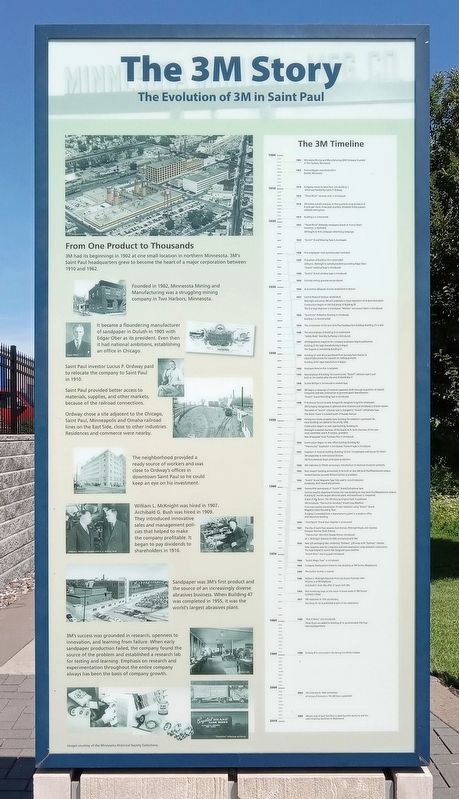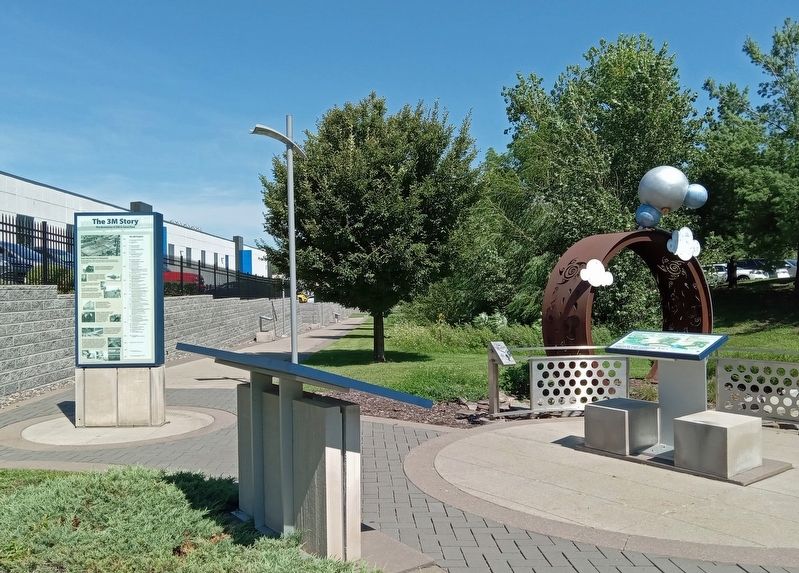Dayton's Bluff in Saint Paul in Ramsey County, Minnesota — The American Midwest (Upper Plains)
The 3M Story
The Evolution of 3M in Saint Paul
From One Product to Thousands
3M had its beginnings in 1902 at one small location in northern Minnesota. 3M's Saint Paul headquarters grew to become the heart of a major corporation between 1910 and 1962.
Founded in 1902, Minnesota Mining and Manufacturing was a struggling mining company in Two Harbors, Minnesota.
It became a floundering manufacturer of sandpaper in Duluth in 1905 with Edgar Ober as its president. Even then it had national ambitions, establishing an office in Chicago.
Saint Paul investor Lucius P. Ordway paid to relocate the company to Saint Paul in 1910.
Saint Paul provided better access to materials, supplies, and other markets, because of the railroad connections.
Ordway chose a site adjacent to the Chicago, Saint Paul, Minneaplis and Omaha railroad lines on the East Side, close to other industries. Residences and commerce were nearby.
The neighborhood provided a ready source of workers and was close to Ordway's offices in downtown Saint Paul so he could keep an eye on his investment.
William L. McKnight was hired in 1907. Archibald G. Bush was hired in 1909. They introduced innovative sales and management policies that helped to make the company profitable. It began to pay dividentds to shareholders in 1916.
Sandpaper was 3M's first product and the source of an increasingly diverse abrasives business. When Building 47 was completed in 1955, it was the world's largest abrasives plant.
3M's success was grounded in research, openness to innovation, and learning from failure. When early sandpaper production failed, the company found the source of the problem and established a research lab for testing and learning. Emphasis on research and experimentation throughout the entire company always has been the basis of company growth.
1902: Minnesota Mining and Manufacturing (3M) Company founded in Two Harbors, Minnesota.
1905: First sandpaper manufactured in Duluth, Minnesota.
1910: Company moves to Saint Paul, into Building 1, which was funded by Lucius P. Ordway.
1914: "Three-M-ite" abrasive cloth is introduced.
1916: 3M makes a profit and pays its first quarterly stock divident of 6 cents per share. It has paid quarterly dividents to the present without interruption.
1919: Building 2 is constructed.
1921: "Three-M-ite" Wetordry sandpaper, based on Francis Okie's invention, is marketed.
3M begins its first sandpaper advertising campaign.
1925: "Scotch" Brand Masking Tape is developed.
1928: First employees' stock purchase plan instituted.
1929: First phase of Building 14 is constructed.
William L. McKnight is named president succeeding Edgar Ober.
"Scotch" electrical tape is introduced.
1930: "Scotch" Brand cellulose tape is introduced.
1932: Colored roofing granules are produced.
1936: Automotive adhesives division established in Detroit.
1937: Central Research Division established.
McKnight announces 3M will undertake a major expansion of its Saint Paul plant.
Construction begins on the first phase of Building 20.
The first tape dispenser is introduced. "Mistlon" non-woven fabric is introduced.
1938: "Scotchlite" Reflective Sheeting is introduced.
Building 1 is reconstructed.
1939: The cornerstone of the new Saint Paul headquarters building (Building 21) is laid.
1940: The second phase of Building 20 is constructed.
"Safety-Walk" Non-Slip Surfacing is introduced.
1941: 3M Megaphone magazine for company employees begins publication.
Building 22 for tape manufacturing is begun.
The flagpole is installed by Building 21.
1942: Buildings 27 and 28 are purchased from Sanitary Farm Dairies to expand laboratories for research on roofing granules.
Building 23 for tape manufacture is begun.
1943: Employee Pension Plan is adopted.
1945: Second phase of Building 14 is constructed. "Scotch" cellulose tape is put back on the market after the end of World War II.
1946: Scottie McTape is introduced to market tape.
1947: 3M begins a campaign of national expansion, both through acquisition of related companies and new construction to promote plant diversification.
"Scotch" Sound Recording Tape is introduced.
1948: First Annual Servie Awards banquet to recognize long-time employees.
3M Company reorganizes its administrative structure and introduces a division system.
The name of "Scotch" cellulose tape is changed to "Scotch" cellophane tape.
The Water Tower is installed south of Reaney Avenue.
1949: Herzog Iron Works property (later Building 99 complex) is purchased. Six more buildings are added to the site by 1958.
Construction begins on new tape building, Building 24.
McKnight is elected chairman of the board; A.G. Bush chairman of the executive committee, and R.P. Carlton, president.
New Employees' Stock Purchase Plan is introduced.
1950: Construction begins on new office building (Building 42)
"Thermo-Fax" Duplicator is introduced, Filament tape is introduced.
1951: Explosion in minerals building (Building 12) kills 13 employees and injures 50 others.
3M establishes its International Division.
3M fluorochemicals begin pilot plant production.
1952: 3M celebrates its fiftieth anniversary. Introduction of electrical insulation products.
1953: New research building announced, to be built on new 3M Saint Paul/Maplewood campus.
Herbert Buetow succeeds Richard Carlton as president.
1954: "Scotch" Brand Magnetic Tape first used to record television broadcasts, both sound and pictures.
1955: Twenty-fifth anniversary of "Scotch" Brand Cellophane tape.
Central research department moves into new building on new Saint Paul/Maplewood campus. Building 47, world's largest abrasives plant, and warehouse is completed.
Brand of the Tartan: The 3M Story by Virginia Huck is published.
3M introduces "Thermo-Fax Secretary" Brand Copy Machine.
First cross-country transmission of color television using "Scotch" Brand Magnetic Video Recording Tape.
Building 2 converted from a manufacturing plant to a modern office and laboratory building.
1956: "Scotchguard" Brand Stain Repeller is announced.
1957: The City of Saint Paul renames East Avenue, McKnight Road, and renames Fauquier Avenue, Bush Avenue.
"Thermo-Fax" Microfilm Reader-Printer introduced.
W.L. McKnight observes his 50th anniversary with 3M.
1958: New gift packaging idea combining "Sasheen" gift wrap with "Sasheen" ribbons.
New magnetic tape for computers and instrumentation using sandwich construction. The tape helped to launch the Vanguard space satellite.
"Scotch Brite" cleaning pads introduced.
1960: "Scotch Magic Tape" is introduced.
1962: Company headquarters moves to new building at 3M Center, Maplewood.
1963: The Carlton Society is created.
1966: William L. McKnight becomes honorary board chairman after 59 years as a 3M employee.
Archibald G. Bush dies after 57 years with 3M.
1969: Neil Armstrong steps on the moon in boots made of 3M Fluorel synthetic rubber.
1977: 3M celebrates its 75th anniversary.
Our Story So Far is published as part of the celebration.
1980: "Post-It Notes" are introduced.
Three floors are added to Building 42 to accommodate the Engineering Department.
1990: Building 99 is constructed in the Herzog Iron Works complex.
2002: 3M celebrates its 100th anniversary.
A Century of Innovation: The 3M Story is published.
2009: 3M sells most of Saint Paul Plant to Saint Paul Port Authority and relocates remaining operations to Maplewood.
Erected by Saint Paul Port Authority, Historic Saint Paul, 3M, United States Environmental Protection Agency.
Topics. This historical marker is listed in these topic lists: Industry & Commerce • Railroads & Streetcars. A significant historical year for this entry is 1910.
Location. 44° 57.827′ N, 93° 3.815′ W. Marker is in Saint Paul, Minnesota, in Ramsey County. It is in Dayton's Bluff. Marker can be reached from 7th Street East near Minnehaha Avenue East. The marker is in Beacon Bluff, an art and history park on part of the grounds of the former 3M complex. Touch for map. Marker is at or near this postal address: 895 7th Street E, Saint Paul MN 55106, United States of America. Touch for directions.
Other nearby markers. At least 8 other markers are within walking distance of this marker. 3M Vision & Growth (here, next to this marker); People & Times: 3M & Saint Paul's East Side (a few steps from this marker); Scotch Brand (a few steps from this marker); Innovations from the Saint Paul Campus (a few steps from this marker); 3M, a Family Affair (within shouting distance of this marker); "The Mining" (within shouting distance of this marker); Marketing 3M & Its Products (within shouting distance of this marker); "Scotch" Tape to the Rescue of General Gray (within shouting distance of this marker). Touch for a list and map of all markers in Saint Paul.
Credits. This page was last revised on September 16, 2023. It was originally submitted on September 15, 2023, by McGhiever of Minneapolis, Minnesota. This page has been viewed 73 times since then and 14 times this year. Photos: 1, 2. submitted on September 15, 2023, by McGhiever of Minneapolis, Minnesota. • J. Makali Bruton was the editor who published this page.

